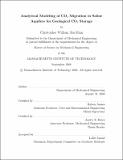| dc.contributor.advisor | Ruben Juanes. | en_US |
| dc.contributor.author | MacMinn, Christopher William | en_US |
| dc.contributor.other | Massachusetts Institute of Technology. Dept. of Mechanical Engineering. | en_US |
| dc.date.accessioned | 2009-06-25T20:37:29Z | |
| dc.date.available | 2009-06-25T20:37:29Z | |
| dc.date.copyright | 2008 | en_US |
| dc.date.issued | 2008 | en_US |
| dc.identifier.uri | http://hdl.handle.net/1721.1/45642 | |
| dc.description | Thesis (S.M.)--Massachusetts Institute of Technology, Dept. of Mechanical Engineering, 2008. | en_US |
| dc.description | This electronic version was submitted by the student author. The certified thesis is available in the Institute Archives and Special Collections. | en_US |
| dc.description | Includes bibliographical references (p. 53-55). | en_US |
| dc.description.abstract | Injection of carbon dioxide into geological formations for long-term storage is widely regarded as a promising tool for reducing global atmospheric CO₂ emissions. Given the environmental and health risks associated with leakage of CO₂ from such a storage site, it is critical to ensure that injected CO₂ remain trapped underground for the foreseeable future. Careful site selection and effective injection methods are the two primary means of addressing this concern, and an accurate understanding of the subsurface spreading and migration of the CO₂ plume during and after injection is essential for both purposes. It is well known that some CO₂ will be trapped in the pore space of the aquifer rock as the plume migrates and spreads; this phenomenon, known as capillary trapping, is an ideal mechanism for geological CO₂ storage because the trapped gas is immobile and distributed over a large area, greatly decreasing the risk of leakage and enhancing the effectiveness of slower, chemical trapping mechanisms. Here, we present an analytical model for the post-injection spreading of a plume of CO₂ in a saline aquifer, both with and without capillary trapping. We solve the governing equation both analytically and numerically, and a comparison of the results for two different initial plume shapes demonstrates the importance of accounting for the true initial plume shape when capillary-trapping effects are considered. We nd that the plume volume converges to a self-similar, power-law trend at late times for any initial shape, but that the plume volume at the onset of this late-time behavior depends strongly on the initial shape even for weakly trapping systems. | en_US |
| dc.description.statementofresponsibility | by Christopher William MacMinn. | en_US |
| dc.format.extent | 55 p. | en_US |
| dc.language.iso | eng | en_US |
| dc.publisher | Massachusetts Institute of Technology | en_US |
| dc.rights | M.I.T. theses are protected by
copyright. They may be viewed from this source for any purpose, but
reproduction or distribution in any format is prohibited without written
permission. See provided URL for inquiries about permission. | en_US |
| dc.rights.uri | http://dspace.mit.edu/handle/1721.1/7582 | en_US |
| dc.subject | Mechanical Engineering. | en_US |
| dc.title | Analytical modeling of CO₂ migration in saline aquifers for geological CO₂ storage | en_US |
| dc.type | Thesis | en_US |
| dc.description.degree | S.M. | en_US |
| dc.contributor.department | Massachusetts Institute of Technology. Department of Mechanical Engineering | |
| dc.identifier.oclc | 374599554 | en_US |
